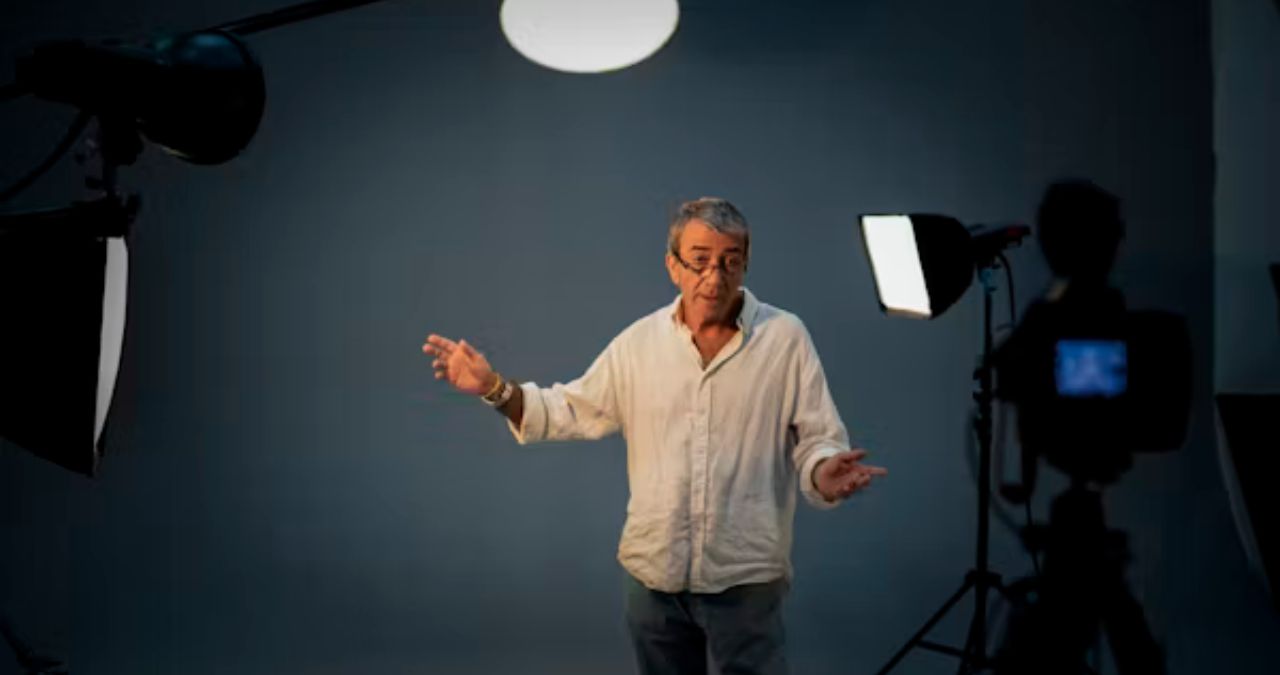BLOG
Emerson Romero: The Forgotten Innovator Who Made Films Accessible for the Deaf Community

BLOG
Slylar box: Redefining storage with modern design

Tired of the clutter invading your space? Do traditional storage solutions seem outdated and uninspiring? Discover the Slylar Box, a revolutionary solution with a modern design that not only organizes your belongings but also enhances the aesthetics of your home. This innovative storage solution combines functionality and style, making it a must-have accessory for those looking to improve their home and keep everything organized. Whether you live in the city or in the suburbs, the Slylar Box is here to transform the way you think about storage. Let’s find out what sets this product apart and why you might fall in love with it!
The Slylar Box is more than just a storage solution; it’s a unique object that perfectly combines aesthetics and practicality. Designed for a modern lifestyle, its clean lines and versatile colors integrate seamlessly with any decor style. You won’t have to sacrifice aesthetics for functionality.
Made from high-quality materials, the Slylar Box promises durability and organization. Its innovative design makes it easy to stack and access, simplifying clutter management. Its thoughtful features meet a variety of needs, whether storing everyday items or seasonal decorations.
User reviews highlight not only its visual appeal but also the way it transforms spaces into serene environments. Customers appreciate the cozy, stylish ambiance it brings to their homes.
Summary
Storage solutions have evolved considerably over the years. Gone are the bulky, unsightly boxes that cluttered our spaces. Today, we look for items that combine functionality and aesthetics.
Discover the Slylar Box: a revolution in modern storage. Its clean lines and contemporary appeal make it an exceptional choice for both home and office use. This innovative product not only helps you organize but also enhances your decor.
Whether you’re looking to store seasonal items or simply organize your space, the Slylar Box will meet your needs without sacrificing style. Discover how this exceptional box can transform the way you manage storage and organization.
Skylar Box: Redefining Storage with Modern Design
The Slylar Box is revolutionizing the world of storage solutions. Combining functionality and contemporary design, it blends seamlessly into any space. Made with quality materials, this box is not only stylish but also stands up to daily use.
Its clean lines and minimalist aesthetic suit modern tastes, offering ample storage space for a variety of items. Whether for the office, living room, or bedroom, the Slylar Box blends seamlessly with your decor.
With innovative features like easy-open lids and stackable designs, organization has never been so stylish. Say goodbye to clutter and hello to elegance with the Slylar Box.
Product Information
The Slylar Box combines functionality with elegant aesthetics. Designed to meet modern storage needs, it blends seamlessly into any space in your home or office. Its minimalist design complements a variety of decor styles.
Made with high-quality materials, the Slylar Box ensures durability and longevity. Its spacious interior offers ample space to store your essentials while maintaining order. Say goodbye to clutter with this elegant solution.
Available in various colors and sizes, the Slylar Box offers versatility for every taste. Whether storing books, toys, or office supplies, its sleek design makes it an attractive addition to any decor.
Details
The Slylar Box is designed with modern aesthetics and functionality in mind. Its sleek design blends seamlessly into any space, enhancing your decor and organization. Available in various colors, it’s sure to suit all tastes.
Made with high-quality materials, the Slylar Box ensures durability and a lightweight design. It offers ample storage capacity without compromising style. Its ingenious design incorporates easy-access openings for added convenience.
In addition, its modular system allows the boxes to be stacked or arranged as needed. This versatility makes it perfect for any room, whether it’s the living room, bedroom, or office. Discover how innovative storage solutions can enhance your home.
Customer Reviews
Customers praise the Slylar Box, highlighting its elegant design and functionality. Many appreciate its seamless integration into different interiors and its ample storage space.
Reviews highlight its innovative features that simplify organization. Users value the box’s versatility, allowing it to store everything from toys to seasonal clothing.
Furthermore, quality of service is a strong point in reviews. Customers often highlight the prompt customer service and fast delivery times, which enhance their experience with this modern storage solution. The enthusiasm for the Slylar Box is palpable among users, who feel they have found the perfect combination of style and practicality in their home.
Customer Service
Customer service is fundamental to the Slylar Box experience. The team is committed to making every customer feel valued and heard. If you have questions about your order or need help with setup, support is just a click away.
The team offers multiple communication channels, including live chat, email, and phone support. You can contact us using the method that is most convenient for you. Our expert advisors are trained to handle inquiries quickly and efficiently.
Customer feedback highlights the responsiveness of the support team. Many appreciate the speed with which their concerns are addressed, which simplifies and speeds up the purchasing process.
About Us
At Slylar Box, we believe that storage should not only be functional but also enrich your space. Our mission is to offer innovative solutions that integrate seamlessly with modern aesthetics. We understand the importance of everyday organization.
Our team is made up of design enthusiasts and pragmatists committed to pushing the boundaries. Each product reflects our passion for quality and style. We prioritize durable materials and thoughtful designs that meet diverse needs.
We pride ourselves on creating versatile products suitable for all environments, from home to office. By prioritizing customer satisfaction, we seek to create a community where elegance and smart organization go hand in hand. Join us in rethinking the way you get organized!
Follow Us
Stay connected with us on social media. Follow Slylar Box on platforms like Instagram, Facebook, and Pinterest to stay up to date with the latest news and inspiration. We love sharing how our customers use Slylar Box in their homes.
Join a community of design enthusiasts who appreciate modern aesthetics and functional storage solutions. Follow us by liking, commenting, or sharing your creative ideas with the Slylar Box. Your feedback helps us improve and innovate.
Don’t miss out on our exclusive promotions and sneak peeks at our upcoming products! Sign up for our newsletter for direct access to Slylar Box news; we promise you won’t regret it.
Conclusion
The Slylar Box is more than just a storage solution; it’s a statement piece. With its modern design, it enhances any space while offering optimal functionality. Whether you’re looking to organize your home or simply add a touch of style, the Slylar Box fits perfectly into your lifestyle.
With its unique features and positive customer reviews attesting to its quality, this product clearly stands out in the competitive storage solutions market. Our commitment to quality customer service guarantees you support at all times.
BLOG
ReaperScans Unveiled: The Best Free Resources for Manga Lovers

Are you a manga enthusiast searching for your next great read? If so, you’re in for a treat. ReaperScans is quickly becoming the go-to platform for manga lovers everywhere. With its diverse library and user-friendly interface, it offers something special to both casual readers and die-hard fans alike. Whether you’re looking to dive into thrilling adventures or heartwarming romances, ReaperScans has got you covered.
What started as a small community-driven project has blossomed into an extensive repository of titles that cater to all genres. The best part? It’s completely free! So grab your favorite snacks, settle in, and let’s explore what makes ReaperScans a must-visit destination for every manga lover out there.
What is ReaperScans and its History
ReaperScans is a digital haven for manga fans, offering an impressive collection of titles across various genres. Founded by passionate readers and artists, it began as a simple scanlation group dedicated to sharing beloved stories with the world.
Over time, ReaperScans evolved into a thriving community where users can not only read but also engage in discussions about their favorite series. The platform prioritizes quality content while ensuring that every release meets high standards of translation and artwork.
With its user-friendly interface and frequent updates, ReaperScans has become synonymous with free manga access. This commitment fosters a welcoming environment for newcomers and veterans alike. As the library continues to grow, so does the excitement surrounding upcoming releases that keep readers coming back for more.
Top 5 Manga Titles Available on ReaperScans
ReaperScans boasts an impressive collection of manga titles that cater to diverse tastes. Here are five standout selections.
First up is “Tomo-chan Is a Girl!” This romantic comedy follows Tomo, who struggles to have her childhood friend see her as more than just a buddy. The humor and relatable characters make it a must-read.
Next, don’t miss “Solo Leveling.” This action-packed series immerses readers in a world where hunters battle monstrous threats. The stunning artwork enhances the thrilling storyline.
For those yearning for fantasy, “The Beginning After the End” offers an incredible journey of reincarnation and self-discovery. Its rich lore keeps fans engaged from start to finish.
Another gem is “My Dress-Up Darling.” It beautifully blends romance with the art of cosplay, showcasing creativity through its captivating narrative.
Lastly, “Jujutsu Kaisen” has gained immense popularity for its gripping plot and dynamic battles involving curses and sorcerers. These titles truly highlight what ReaperScans has to offer.
How to Use ReaperScans: A Step by Step Guide
Using ReaperScans is straightforward and user-friendly. Start by visiting the official website. The clean layout makes navigation easy.
Once on the homepage, browse through various manga categories or use the search bar for specific titles. Popular series often feature prominently, helping you discover new reads.
Click on a title to access its dedicated page. Here, you’ll find chapter lists along with summaries and release dates. Select your desired chapter to read it online or download it for offline enjoyment.
The reading interface allows for zooming in and out, enhancing your experience whether you’re using a computer or mobile device.
Don’t forget to check back regularly for updates or new releases from your favorite series! Engaging with comments can also connect you with fellow fans who share similar tastes in manga.
Benefits of Using ReaperScans for Manga Reading
ReaperScans offers a seamless reading experience for manga enthusiasts. With an extensive library, you can easily discover titles across various genres. Whether you’re into action, romance, or horror, there’s something for everyone.
The user-friendly interface makes navigation a breeze. You can quickly find your favorite series and track new chapters effortlessly. This convenience keeps readers engaged and coming back for more.
One of the standout features is the quality of scans. Each manga is presented in high resolution, preserving the artwork’s intricate details that fans cherish.
Additionally, ReaperScans often updates its collection with the latest releases. Staying current means never missing out on trending stories or beloved characters.
Community involvement enhances your reading journey too. Readers connect over shared interests and recommendations within forums and comments sections, fostering a sense of belonging among manga lovers everywhere.
Alternatives to ReaperScans for Manga Lovers
For manga enthusiasts seeking alternatives to ReaperScans, several platforms offer diverse selections and unique features.
MangaDex is a popular choice, boasting an extensive library of titles across various genres. Its user-friendly interface makes it easy to navigate.
Another option is MangaRock, which provides a curated collection of both mainstream and indie works. The app also allows for offline reading, making it convenient for on-the-go fans.
If you enjoy community interaction, check out MyAnimeList. Besides manga chapters, users can engage in discussions about their favorite series and authors.
Webtoons offers a different format with vertical scrolling comics that cater to modern storytelling styles. It’s perfect for those who want something fresh alongside traditional manga.
Each platform has its strengths and caters to different preferences within the vibrant world of manga reading.
Featured Artists and Upcoming Releases on ReaperScans
ReaperScans showcases a vibrant community of talented artists, bringing fresh stories and captivating art to manga lovers everywhere. The platform is dedicated to highlighting both established creators and emerging talents, ensuring an exciting mix for readers.
Keep an eye out for upcoming releases featuring fan-favorite series alongside new titles that promise to make waves in the manga world. Each month brings something unique, whether it’s a gripping thriller or a heartwarming slice-of-life tale.
The collaborative spirit at ReaperScans also means fans can engage with their favorite artists directly. Many creators share insights into their work processes through behind-the-scenes content and Q&A sessions.
This connection between artists and readers fosters a sense of community that’s hard to find elsewhere. As you explore the ever-expanding library on ReaperScans, you’ll discover not just stories but the passion that drives these incredible creatives forward.
Conclusion
ReaperScans has become a beloved platform for manga enthusiasts, offering easy access to a variety of titles and an engaging community. With its extensive library and user-friendly interface, readers can easily find their next favorite series without breaking the bank.
The top five manga titles available on ReaperScans showcase both popular mainstream hits and hidden gems, ensuring there’s something for everyone. Navigating the site is straightforward, allowing users to jump right into reading with minimal fuss.
Utilizing ReaperScans comes with numerous benefits: it’s free, offers high-quality scans, and fosters connection among fans through discussions about ongoing stories. For those looking for alternatives or different experiences in the manga world, other platforms are available that cater to diverse tastes.
Featuring talented artists who contribute new works regularly keeps the content fresh and exciting. Upcoming releases promise even more thrilling adventures for avid readers.
For anyone passionate about manga or just starting out in this vibrant genre, exploring what ReaperScans has to offer could be your gateway into countless hours of enjoyment.
BLOG
How to Use FLVTO Effectively: A Step-by-Step Tutorial

Introduction to FLVTO
Are you tired of searching for ways to download your favorite YouTube videos? Look no further! FLVTO is here to simplify the process and make downloading a breeze. Whether you’re looking for music, tutorials, or entertainment clips, this powerful tool allows you to convert and save content effortlessly. With just a few clicks, you can have high-quality files ready for offline enjoyment. In this tutorial, we’ll walk you through each step of using FLVTO effectively so that you can maximize its potential. Ready to dive in? Let’s get started!
Step 1: Download and Install FLVTO
To get started with FLVTO, the first step is downloading and installing the software. Head over to the official FLVTO website for a safe and reliable download. This ensures you’re getting the latest version without any added malware.
Once you land on the site, look for an easy-to-find “Download” button. Click it to initiate your download process. Depending on your internet speed, this should only take a moment.
After downloading, locate the file in your downloads folder or wherever files are saved by default. A simple double-click will start the installation wizard. Follow the prompts carefully; they guide you through each stage of setup.
Make sure to accept any terms of service if prompted, as this is standard practice during installations. Soon enough, FLVTO will be ready for use on your device!
Step 2: Copy the YouTube Video Link
To utilize FLVTO effectively, the next step is to copy the YouTube video link.
Start by navigating to YouTube and find the video you want. Play it briefly or just get a glimpse to ensure it’s what you’re after.
Once you’ve identified your choice, look for the URL in your browser’s address bar at the top. It’s typically a long string starting with “https://”.
Highlight this entire link carefully. Right-click and select “Copy” or use keyboard shortcuts like Ctrl+C on Windows or Command+C on Mac.
Now that you have the link stored in your clipboard, you’re ready for the next step in this simple process!
Step 3: Paste the Link in FLVTO
Once you’ve copied the YouTube video link, it’s time to head over to FLVTO. The interface is user-friendly and straightforward, making this step a breeze.
Locate the designated box on the site where you can paste your video link. Simply click inside that area and use either right-click or keyboard shortcut (Ctrl + V) to insert your URL.
Ensure there are no extra spaces or characters in the link after pasting. A clean link guarantees smoother processing later on.
After pasting, take a moment to double-check everything looks correct. Typos can lead to errors during conversion, so it’s worth confirming before proceeding.
With your video link successfully inserted into FLVTO, you’re ready for the next exciting steps in transforming that content into your preferred format!
Step 4: Choose Your Preferred File Format
Once you’ve pasted the YouTube link into FLVTO, it’s time to pick your file format. This choice is crucial as it determines how you’ll access the audio or video later.
FLVTO offers various formats like MP3, MP4, and more. If you’re looking for audio only, MP3 is a solid option. It provides excellent sound quality while keeping file sizes manageable.
For a complete viewing experience, consider selecting MP4 if you want both picture and sound. It’s widely compatible with most devices and platforms.
Take a moment to think about where you’ll play this file. Different devices may support different formats better than others. Choosing wisely ensures smooth playback without hiccups down the line.
Your selection here can enhance your overall enjoyment of the content you’ve chosen to download from YouTube through FLVTO.
Step 5: Click “Convert To” Button
After selecting your preferred file format, it’s time for the final step. Locate the “Convert To” button on FLVTO’s interface.
This button is your gateway to transforming that video link into a downloadable file. Clicking it initiates the conversion process, which typically takes just a few moments. You’ll see a progress bar indicating how far along the conversion is.
Stay patient during this brief wait; it won’t take long for your file to be ready. Once complete, you will receive an option to download your newly converted audio or video file.
Make sure to keep an eye out for any prompts that may appear after clicking “Convert To.” These often guide you through saving your content seamlessly and quickly!
Tips for Optimal Use of FLVTO
To make the most of FLVTO, start by ensuring a stable internet connection. A reliable network will speed up your downloads and reduce errors.
Next, check the quality settings before converting files. Higher bit rates yield better audio experiences. Don’t settle for mediocre sound when you can have crisp clarity.
Also, keep an eye on file sizes. Sometimes larger files take longer to download or may require more storage space than anticipated. Adjust your format choice accordingly.
Utilize FLVTO’s options wisely. There are various formats available—choose one that suits your playback device best, whether it’s MP3 for music or MP4 for video content.
Stay updated with any new features or changes in FLVTO’s interface. This ensures you’re using all available tools effectively without missing out on enhancements that could improve your experience further.
Troubleshooting Common Issues
Using FLVTO can occasionally present some challenges. If you find that your video isn’t converting, check the link first. Ensure it’s copied correctly from YouTube without any extra spaces or characters.
Another common issue is slow conversion times. This might be due to heavy traffic on the site or a temporary glitch. Try refreshing the page or waiting a few moments before attempting again.
If you encounter format compatibility problems, double-check that your chosen output format is supported by FLVTO. Switching between formats can sometimes resolve unexpected issues.
If you’re experiencing persistent errors, consider clearing your browser’s cache and cookies. A fresh start may help eliminate hidden obstacles hindering performance.
Conclusion
Using FLVTO can enhance your media experience by allowing you to convert YouTube videos into audio and video formats easily. Following the steps outlined ensures a smooth conversion process, whether you’re looking for music tracks or educational content. Remember to take advantage of the tips shared for optimal use, which can help prevent common issues that users might face.
With FLVTO in your toolkit, accessing multimedia from YouTube becomes simple and efficient. Now you’re equipped with all the essential knowledge to make the most out of this powerful tool. Happy converting!
-

 TECH3 months ago
TECH3 months ago185.63.263.20: Insights into This Unusual IPv4 Address
-

 BLOG3 months ago
BLOG3 months agoXaller: A Comprehensive Guide to Understanding Its Significance and Applications
-

 BLOG3 months ago
BLOG3 months agoKorpenpelloz: An In-Depth Exploration of Its Significance
-

 BLOG3 months ago
BLOG3 months agoRosy Kellogg: Uncovering the Life and Legacy of a Renowned Figure
-

 BLOG3 months ago
BLOG3 months agoCarmenton.xyz: Everything You Need To Know
-

 HOME3 months ago
HOME3 months agoTEK-102: A Comprehensive Guide to Its Features, Uses, and Industry Impact
-

 BLOG3 months ago
BLOG3 months agoZepbound: A Comprehensive Guide to Weight Loss
-

 BLOG3 months ago
BLOG3 months agoAmikaf16: An In-Depth Overview
